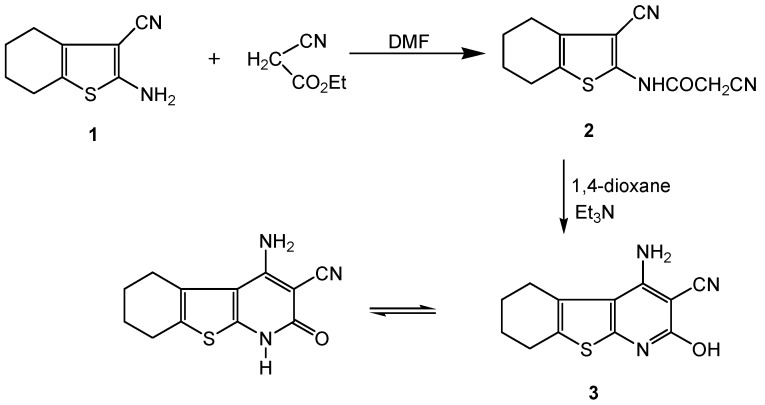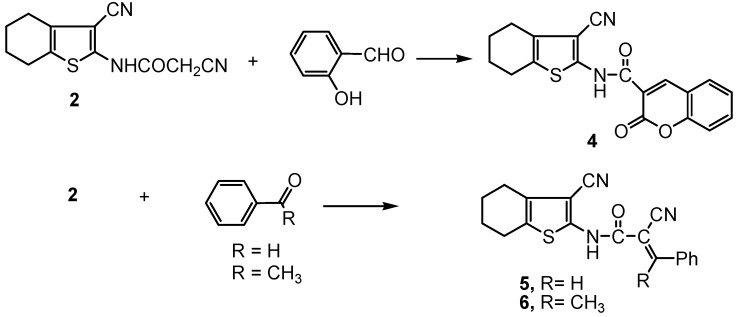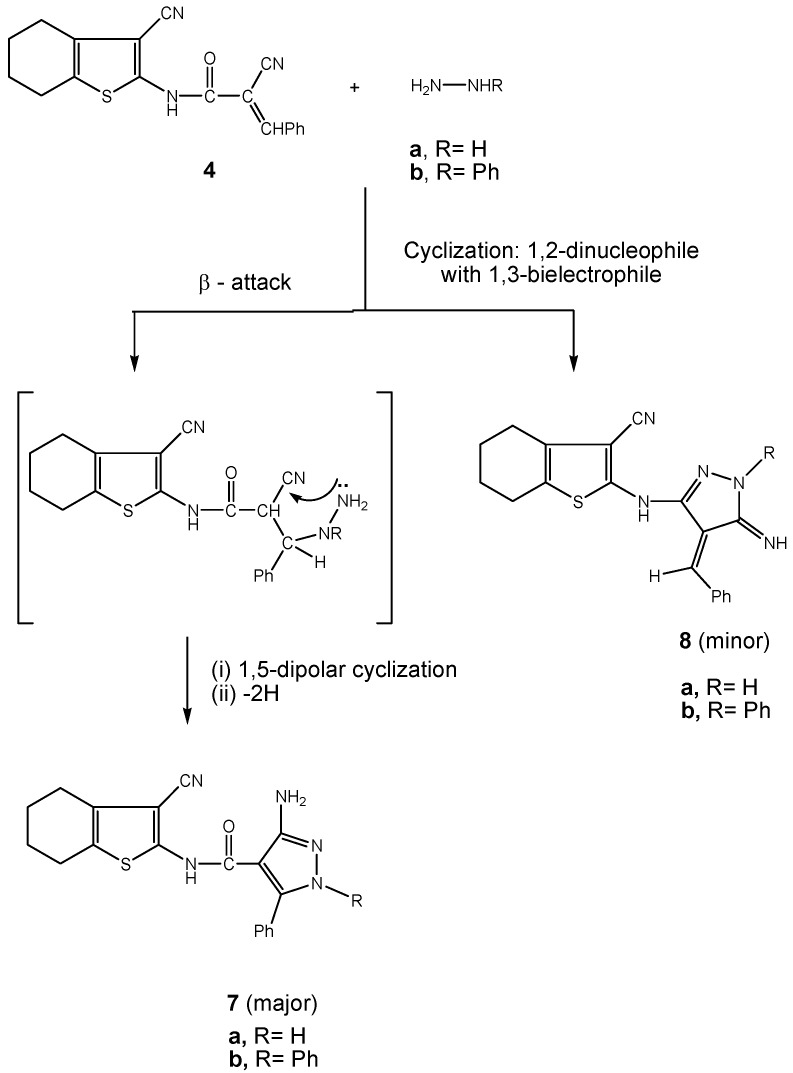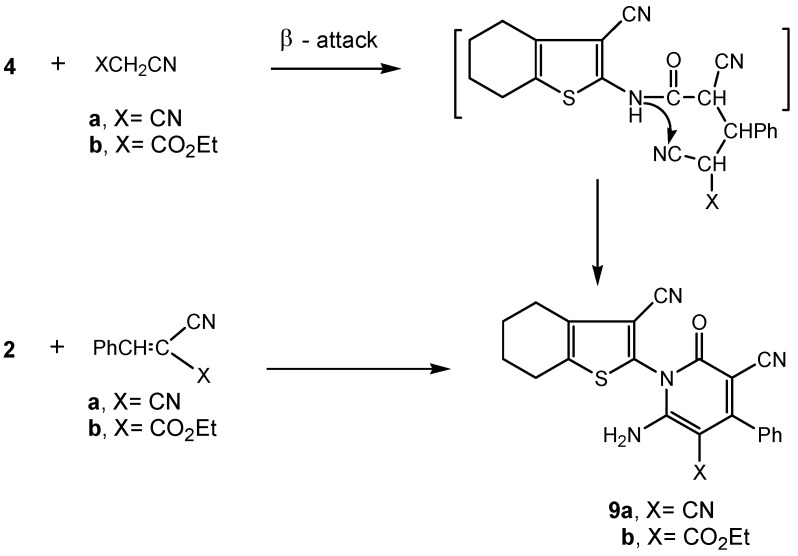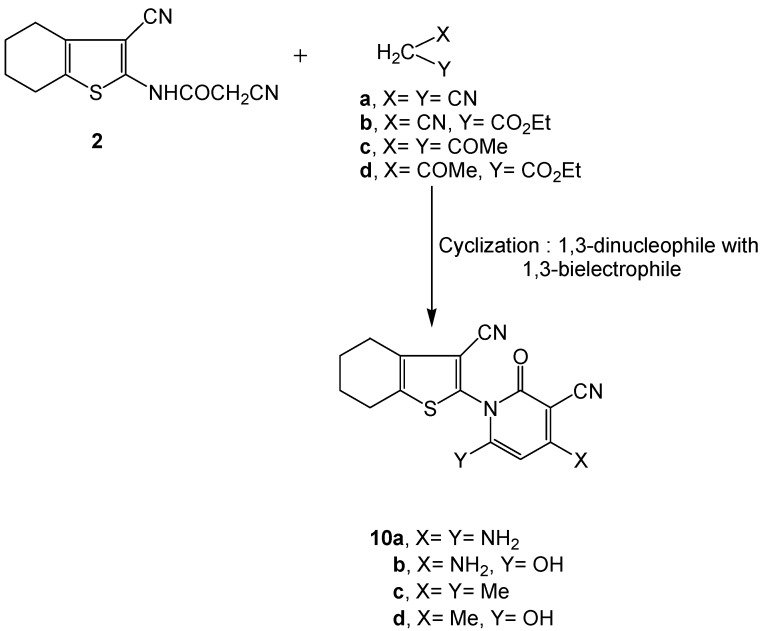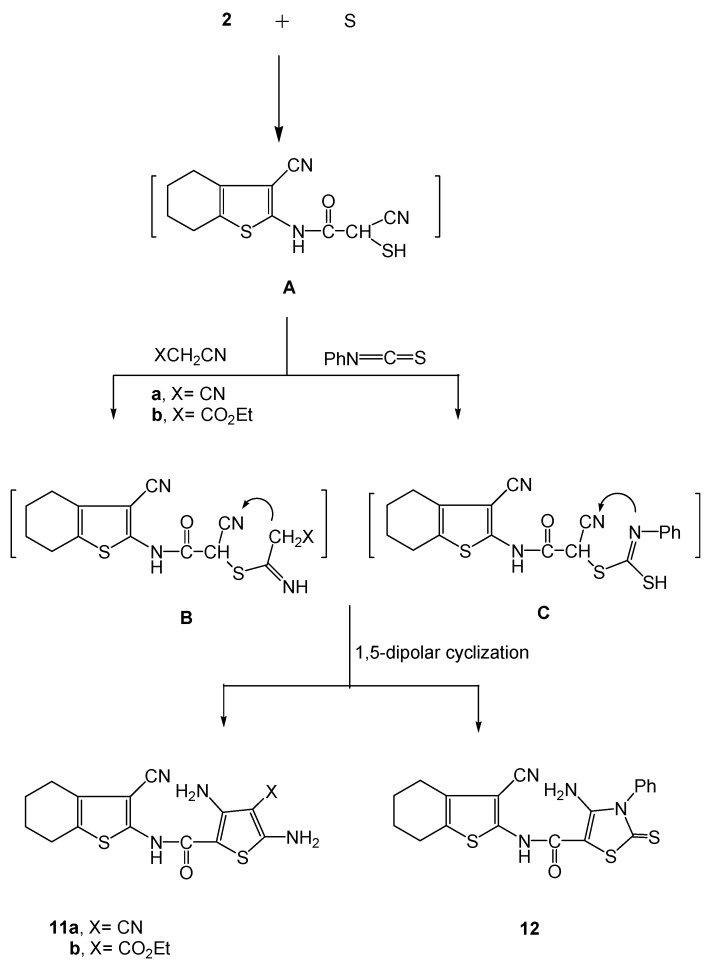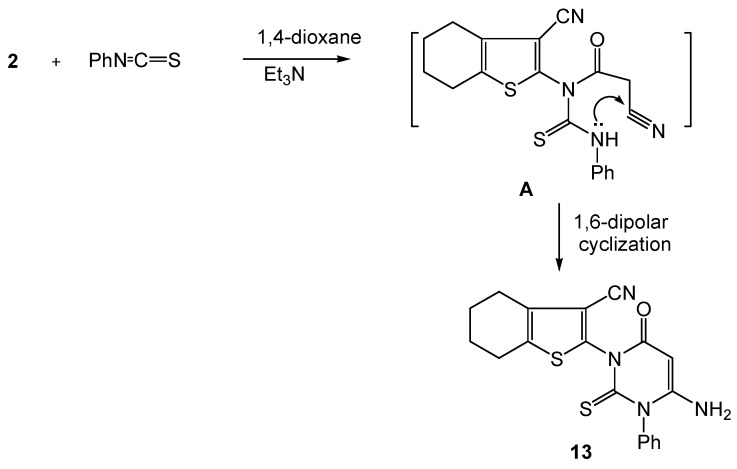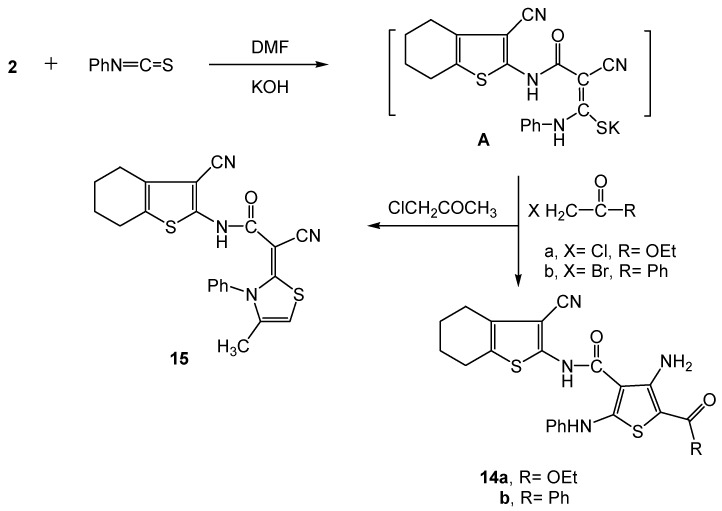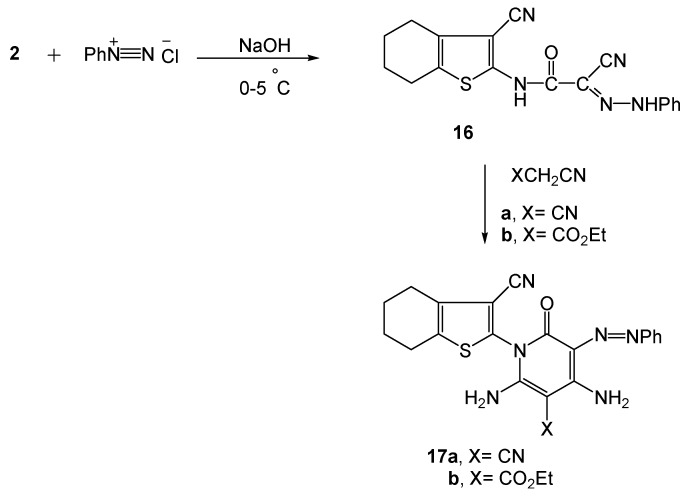Abstract
The reaction of 2-amino-3-cyano-4,5,6,7-tetrahydrobenzo[b]thiophene with ethyl cyanoacetate gave 2-cyano-N-(3-cyano-4,5,6,7-tetrahydrobenzo[b]thiophen-2-yl)-acetamide. The latter was used to synthesize different heterocyclic derivatives comprising thiophene, thiazole, pyrazole, pyridine, pyrimidine, and coumarin rings. The mechanistic and synthetic pathways depended on regioselective attack and/or cyclization by the cyanoacetamido moiety in the key precursor on various chemical reagents. The competition of the reaction pathways including dipolar cyclization, dinucleophilic-bielectrophilic attack, β-attack, Gewald-type attack, and condensation reactions led to the diversity of the synthesized products. The antitumor activities of the synthesized products were studied and evaluated. Most of the compounds revealed high inhibitory effects when screened in vitro for their antiproliferative activity. Three human cancer cell lines, namely, breast adenocarcinoma (MCF-7), non-small cell lung cancer (NCI-H460) and CNS cancer (SF-268) were used in the screening tests. The simplicity of the synthetic procedures which mainly involved one-pot reactions under mild reaction conditions, the convenience of yield production and the diversity of the reactive sites in the produced systems play a valuable role for further heterocyclic transformations and further biological investigations.
Keywords: 4,5,6,7-tetrahydrobenzo[b]thiophene; thiazole; pyrazole; pyridine; antitumor
1. Introduction
Benzothiophene systems and their substituted derivatives have attracted a great deal of interest over the years. Their aromatic character contributes to their reactivity, stability and chemical and electronic properties. A vast number of heterocyclic derivatives observed in natural products have beenreported [1,2]. On the other side, they find increasing application as superconductors [3,4], optoelectronics [5,6], light emission diodes LEDs, and non-linear optical (NLO) chromophores [7,8]. Besides, their pharmacological profiles as antimicrobial [9,10], antifungal [11], antiinflammatory [12], antiproliferative [13,14,15] and antioxidant [16] agents have led to an enduring interest in the development of various methods for their synthesis. The most efficient protocols for carrying out the synthesis of such thiophene derivatives are the Gewald method [17,18], intramolecular cyclization via both nucleophilic displacement [14,19] and thio-Claisen rearrangement [20], and dehydrophoto- cyclization [21,22]. Of particular interest are methods that utilize new classes of precursors. Among the many synthetic methods available are C-C bond formation using Montmorillonite K-10 as Friedel Crafts catalyst [23]. C-C and C-N bond formation via transition metal catalyzed processes involving palladium-mediated cross-coupling cyclizations (e.g., Suzuki, Sonogashira and Buchwald-Hartwig cross coupling), also feature heavily [24,25,26,27,28]. Within the scope of these diverse synthetic methods and the utility of thiophene-based systems and in continuation to our interest in the design of bioactive heterocycles [29,30,31], we focused our efforts to developing novel highly substituted and polyfunctional heterocyclic compounds based on the key precursor 2-cyano-N-(3-cyano-4,5,6,7-tetrahydrobenzo[b]-thiophen-2-yl)-acetamide (2) and evaluating their antitumor activities.
2. Results and Discussion
2.1. Chemistry
The synthetic strategies adopted to obtain the newly synthesized compounds 3-17 depended on the regioselective attack on the cyanoacetamido moiety of the key precursor 2 by different reagents, which, in one or two steps added a highly functionalized substituent or heterocyclic ring to the molecule. The mechanistic pathways for our protocol are outlined in Scheme 1, Scheme 2, Scheme 3, Scheme 4, Scheme 5, Scheme 6, Scheme 7, Scheme 8 and Scheme 9. CHNS microanalytical data, IR, 1H-NMR and MS spectral data are indicated in the Experimental section.
Scheme 1.
Synthesis of the precursor 2 and its cyclized product 3.
Scheme 2.
Synthesis of the coumarin derivative 4 and benzal derivatives 5 and 6.
Scheme 3.
Synthesis of pyrazole systems 7a,b.
Scheme 4.
Synthesis of pyridone derivatives 9a,b.
Scheme 5.
Synthesis of 2-pyridone derivatives 10a-d.
Scheme 6.
Synthesis of the highly functionalized thiophenes 11a,b and thiazole 12.
Scheme 7.
Synthesis of 2-pyrimidone-6-thione 13.
Scheme 8.
Synthesis of thiophene derivatives 14a,b and the thiazole 15.
Scheme 9.
Synthesis of 2-pyridone-3-phenylazo derivatives 17a,b.
The reaction of 2-amino-3-cyano-4,5,6,7-tetrahydrobenzo[b]thiophene (1) [32] with ethyl cyano-acetate gave 2-cyano-N-(3-cyano-4,5,6,7-tetrahydrobenzo[b]thiophen-2-yl)-acetamide 2 ( Scheme 1). The IR spectrum of 2 revealed two CN stretching bands at 2,262 and 2,196 cm−1, and a characteristic C=O stretching at 1,696 cm−1. Moreover, the 1H-NMR spectrum exhibited a multiplet due to four CH2 groups at δ 1.70-2.60, a singlet at δ 4.11 for the acetamido CH2 and a singlet at δ 6.94 ppm for the amidic NH. GC-MS analysis of compound 2 exhibited a [M+] ion (m/z 245), confirming the molecular weight of this compound. The peak at m/z 178 indicated the fragmentation of [COCH2CN]+ (m/z 68) from [M+ + 1]. The base peak observed at m/z 150 represented the fragmentation of [CNHCOCH2CN]+ (m/z 95) from the [M+] ion. Compound 2 underwent ready cyclization when heated in 1,4-dioxane containing triethylamine to give the tetrahydrobenzo[4,5]thieno[2,3-b]pyridine derivative 3 (Scheme 1).
The absence of one of the two CN functions (IR) and of δ singlet CH2 (1H NMR) observed in compound 2 as well as the appearance of a NH2 singlet at δ 3.61 ppm (1H-NMR) confirmed the fused structure 3. It is noteworthy that the IR spectrum of compound 3 showed a C=O stretching band at 1,621 cm−1 and its 1H-NMR showed a D2O exchangeable singlet at δ 6.97 ppm corresponding to the NH group, confirming that 3 exists in both keto and enol forms. Compound 3 revealed a [M+] (m/z 245) which is also the base peak.
The reactivity of compound 2 towards various chemical reagents was investigated with the aim to producing thiophene systems with potential biological activities. Thus, the reaction of 2 with salicylaldehyde gave the coumarin derivative 4. On the other hand, the reaction of 2 with either benzaldehyde or acetophenone gave the benzylidene derivatives 5 and 6, respectively (Scheme 2).
All collected data for compounds 4-6 were consistent with the proposed structures. Thus, the observation of δ-1H benzylidine C=CH at 8.56 ppm in the 1H-NMR spectrum of 5 and a coumarin C4-H proton at δ 6.94 ppm in the 1H-NMR spectrum of 4, as well as the appearance of a high frequency C=O stretching at 1,715 cm−1 cited for the coumarin oxo function besides the absence of the cyanoacetamido CN observed in the starting material 2, in the IR spectrum of 4 proved the expected structures. Compounds 5 and 4 revealed molecular ion peaks [M+] at m/z 333 and [M+ − 1] (m/z 349), corresponding to the molecular formulae C19H15N3OS and C19H14N2O3S, respectively. A base peak at m/z 266 due to splitting of the fragment ion [C(=O)-C-CN]+ (m/z 66) from the [M+ − 1] ion of 5, and a base peak at m/z 172 which resulted from the fragmentation of [3-CN-4,5,6,7-tetrahydrobenzo[b]thiophene-2-NH]+ (m/z 177) from the [M+ − 1] ion of 4 were observed in their respective mass spectra.
When compound 2 was reacted with acetophenone in the presence of ammonium acetate in an oil bath at 140 °C the Knoevenagel condensation product 6 was obtained (Scheme 2). The structure of compound 6 was based on analytical and spectral data (see Experimental section). Moreover, the GC-MS spectrum of compound 6 revealed a molecular ion peak [M+ − 1] at m/z 346, a base peak at m/z 150, resulting from the fragmentation of [CNHC(=O)C(CN)=C(CH3Ph)]+ (m/z 197) from the [M+] ion, and a fragment ion peak at m/z 178 due to the fragmentation of [C(=O)C(CN)=C(CH3Ph)]+ (m/z 170) from the [M+ + 1] ion peak.
When compound 4 reacted with either hydrazine hydrate or phenyl hydrazine, the respective pyrazole systems 7a,b were obtained as the major products (Scheme 3). The reaction involves β-attack on the C(=O)C=C moiety in 4 with subsequent 1,5-intramolecular dipolar cyclization and concomitant aromatization.
Minor products 8a,b were also obtained through the first condensation with the amide C=O followed by cyclization. Microanalysis and spectral data of 7a,b were fully consistent with the proposed structures. The mass spectrum of the pyrazole system 7b exhibited a molecular ion peak [M+] (m/z 439) corresponding to molecular formula C25H21N5OS.
On the other hand, treatment of the benzylidene derivative 4 with methylene carbonitrile reagents (XCH2CN; X = CN, X = CO2Et) afforded the respective pyridone derivatives 9a,b (Scheme 4). The reaction took place via β-attack on the benzylidene moiety in 4 followed by 1,6-intramolecular dipolar cyclization with concomitant aromatization. The IR spectrum of 9a revealed the presence of three CN stretching bands at υ 2,253, 2,223 and 2,209 cm−1. Moreover, the 1H-NMR spectra of 9a and 9b showed the presence of one singlet for each at δ 3.61 and δ 3.41 ppm, respectively, due to the presence of the NH2 group. Compound 9b showed a triplet at δ 1.21 for the ester CH3 group and a quartet at δ 4.30 corresponding to the ester CH2 group. Moreover, in the mass spectrum of 9a the existing [M+] ion (m/z 397) corresponding to the formula C22H15N5OS and representing the base peak was observed, whereas the mass spectrum of 9b exhibited a molecular ion peak [M+] at m/z = 444 confirming its molecular formula C24H20N4O3S.
Further confirmation of the reaction products 9a,b was achieved through an alternative synthetic route involving treatment of the starting compound 2 with benzylidene carbonitrile reagents (PhCH=C(CN)X; X = CN; X = CO2Et) to afford the same pyridone derivatives 9a,b (verified by IR fingerprint, m.p. and mixed m.p.) with better yields (80%, 86%) than in their formation by the reaction of compound 4 and either malononitrile (75% yield) or ethyl cyanoacetate (73% yield) (Scheme 4).
By subjecting the starting material 2 to reaction with active methylene reagents (X CH2Y; X = Y = CN; X = CN, Y = CO2Et; X = Y = COCH3 or X = COCH3, Y = CO2Et) the respective 2-pyridone derivatives 10a-d were obtained (Scheme 5).
All data for compounds 10a-d were consistent with the proposed structures. Thus, the absence of the δ-1H CH2 cited for the acetamido methylene protons observed with 2 at δ 4.11 ppm and the appearance of the pyridine C5-H protons at δ 7.89, 6.92, 6.51 and 6.88 ppm in the respective 1H-NMR spectra of 10a-d confirmed the proposed structures. Moreover, the CH3 proton singlets were recorded at δ 2.11 and 2.36 ppm with compound 10c and at δ 2.55 ppm with 10d, whereas the δ-1H signals for OH were integrated at 11.89 and 12.10 ppm in the respective 1H-NMR spectra of compounds 10b,d. The mass spectra of 10a,b exhibited a common peak at m/z 311 which corresponded to their [M+] and [M+ − 1] ions, respectively. Another common peak was also observed at m/z 296 due to splitting of NH2 from their respective [M+ + 1] and [M+] molecular ions. The peak observed for 10a at m/z 282 is due to the fragmentation of two NH2 from [M+ + 3], while that observed for 10b at m/z 285 corresponded to the loss of CN group from its [M+ − 1]. The mass spectrum of 10b exhibited two fragment ion peaks at m/z 219 and 164 due to fragmentation of [C(=O)-C(CN)=C-(NH2)]+ from [M+ + 1] and of functionalized pyridone (C6H5N3O2) from [M+ + 3]. The mass spectrum of 10c displayed a [M+] base peak at m/z 309 corresponding to the molecular formula C17H15N3OS. Compound 10c revealed two main fragment ions at m/z 162 and m/z 147 due to splitting of 3-CN-4,5,6,7-tetrahydrobenzo[b]-thiophene [C9H8NS]+ and the functionalized pyridone C8H7N2O fragments, respectively.
The peak observed at m/z 131 is due to the fragmentation of 2-amino-3-cyano-4,5,6,7-tetrahydrobenzo[b]thiophenyl cation [C9H10N2S]+ from the molecular ion peak [M+] of 10c whereas that observed at m/z 281 resulted from fragmentation of CN from [M+ − 2]. On the other hand, compound 10d exhibited [M+ + 2] at m/z 313 indicating a molecular formula C16H13N3O2S, and a base peak m/z 219 due to fragmentation of [C(=O)-C(CN)=C(CH3)]+ (m/z 93) from its [M+ + 1]. Two fragments observed at m/z 163 and m/z 150 resulted from splitting of 3-cyano-4,5,6,7-tetrahydrobenzo-[b]thiophenyl cation [C9H9NS]+ and functionalized pyridone [C7H6N2O2]+, respectively.
At the other extreme, when compound 2 reacted with elemental sulfur and either of the methylene carbonitrile reagents (X-CH2-CN or X = CN; X = CO2Et) it gave the thiophene derivatives 11a,b, respectively. The reaction of compound 2 with phenyl isothiocyanate and elemental sulfur gave the thiazole-2-thione derivative 12. Formation of 11a,b took place through intermediate formation of A and B, while the formation of 12 occurred through intermediacy of A and C (Scheme 6).
The 1H-NMR spectrum of compound 11a revealed the existence of two singlets at δ 3.34 and 3.38 ppm corresponding to two NH2 groups, while compound 11b showed two singlets at δ 3.31 and 3.35 ppm corresponding to the two NH2 groups, a triplet at δ 1.12 for the ester CH3 group and a quartet at δ 3.49 for the ester CH2 group. GC-MS analysis of 11a,b and 12 showed molecular ion peaks [M+ + 3] m/z 346, [M+ + 2] m/z 392 and [M+] m/z 412. The main fragmentation of 11a,b and 12 gave the most abundant peak recorded at m/z 150, which corresponded to the fragment ion [C8H8NS]+ resulting from the fragmentation of [3,5-di-NH2-4-CN-thiophene-2-CONHC]+ (m/z 193), [3,5-di-NH2-4-C(=O)OEt-thiophene-2-CONHC]+ (m/z 240) and [4-NH2-3-Ph-2-thione-2,3- dihydrothiazole-5-CONHC]+ (m/z 262), respectively, from their corresponding molecular ions [M+]. The peak observed at m/z 150 represented the base peak for 11a. A base peak observed at m/z 362 in the mass spectrum of 11b indicated the fragmentation of [C-NH2]+ (m/z 28) from the [M+] ion, whereas the base peak observed at m/z 93 in the mass spectrum of 12 corresponded to the cleavage of Ph-NH2. A common peak observed at m/z 178 in the mass spectra of 11a,b and 12 indicated the loss of 2-NH2-3-CN-4,5,6,7-tetrahydrobenzo[b]-thiophene.
Next, we moved to the studying of the the reaction of compound 2 with phenyl isothiocyanate in 1,4-dioxane containing triethylamine. The reaction involved a nucleophilic attack by the amidic NH function in 2 on the C=S terminal of the isocyanate reagent to produce the acyclic intermediate A. The latter then underwent 1,6-dipolar cyclization to afford the 6-thioxo-2-pyrimidone derivative 13 as the major product (Scheme 7).
The data obtained from the IR, 1H-NMR and MS spectra are in agreement with the proposed structure. Thus, the 1H-NMR of compound 13 exhibited singlets at δ 6.92 and 3.83 ppm due to pyrimidine C3-H and NH2, respectively. The mass spectrum of 13 revealed a [M+ + 2] ion peak at m/z 382, a base peak at m/z 313 due to fragmentation of [C(=O)-CH=C-NH2] + (m/z 69) from the [M+ + 2] as well as a fragment ion at m/z 255 due to fragmentation of [C(=S)=N-C(=O)-C=C-NH2]+ (m/z 126) from [M+ + 1].
On the other hand, we are involved in a comprehensive programme studying the reactivity of active methylene reagents towards phenyl isothiocyanate in basic dimethylformamide followed by heterocyclization with α-halocarbonyl compounds. These reactions lead to the formation of either thiophene or thiazole systems or both, depending on reaction conditions and the nature of the α-halo-carbonyl reagent [33]. Thus, subjecting the active methylene key precursor 2 to the aforementioned reaction using α-halocarbonyl reagents XCH2C(=O)R (X = Cl, R = OEt; X = Br, R = Ph; X = Cl, R = CH3) afforded the functionalized thiophene and thiazole derivatives 14a,b and 15, respectively (Scheme 8). The reaction took place through the intermediacy of the potassium sulphide salt A. The disappearance of δ-1H CH2 singlet observed in the precursor 2, and the appearance of D2O exchangeable NH2 singlets at δ 4.37 and δ 4.80 ppm for compounds 14a and 14b, respectively, as well as the appearance of a δ-1H singlet at 6.67 ppm assigned to a thiazole C5-H proton in compound 15 are considered sufficient proof for the structures of 14a,b and 15. Moreover, The mass spectra of 14a,b and 15 displayed [M+] ion peaks at m/z 466, 498 and 418, respectively, corresponding to their respective molecular formulae C23H22N4O3S2, C27H22N4O2S2 and C22H18N4OS2. The main fragmentation of the title compounds revealed three important common peaks: m/z 77 due to [phenyl]+, m/z 178 due to 2-NH2-3-CN-4,5,6,7-tetrahydrobenzo[b]thiophene, and m/z 150 to [C8H8NS]+. Such m/z peaks resulted from the fragmentation of [3-NH2-2-COOEt-5-NHPh-thiophene-4-CONH-C]+ (m/z 316), [3-NH2-2-COPh-5-NHPh-thiophene-4-CONH-C]+ (m/z 348) and [4-CH3-3-Ph-3H-thiazol-2-ylidine-C-(CN)-CONH-C]+ (m/z 268) from their corresponding [M+] ions. The peak observed at m/z 77 due to [phenyl]+ represented the base peak for both compounds 14a,b.
Compound 15 displayed a base peak at m/z 241 due to the loss of a 2-amino-3-cyano-4,5,6,7-tetra-0hydrobenzo[b]thiophenyl cation (m/z 178) from its [M+ + 1] molecular ion. Other fragment ions were observed in the mass spectra of 14a,b and 15 at their expected m/z values.
On the other hand, compound 2 reacted with benzenediazonium chloride to give the phenylhydrazo derivative 16. The latter compound reacted with either malononitrile or ethyl cyanoacetate to give the 3-phenylazo-pyridone derivatives 17a and 17b, respectively (Scheme 9). The structural assignments of 16, 17a,b were based on analytical and spectral data. Thus, the 1H-NMR spectrum of compound 16 revealed two singlets at δ 9.14 and 10.88 ppm (D2O exchangeable) due to the two NH groups. Moreover, the mass spectrum of 16 showed a molecular ion peak at m/z 349 [M+], and a base peak at m/z 178 which corresponded to the loss of [C(=O)-C(CN)=N-NHPh]+ (m/z 172) from [M+ + 1]. Fragment ions at m/z 149 due to fragmentation of [C-(NH)-C(=O)-C(CN)=N-NHPh]+ (m/z 197) from [M+ − 1], and the peak at m/z 167 resulting from fragment ion [NH-C(=O)-C(CN)=N-NHPh]+ (m/z 187) from [M+ + 5].
Common features of compounds 17a,b are their strong carbonyl absorptions around 1,680 cm−1 in their IR spectra, in addition to the ester C=O peak at 1,739 cm−1. Moreover, the 1H-NMR spectra of 17a and 17b showed a singlet a δ ~ 3.10 (D2O exchangeable) corresponding for the NH2 protons. Compound 17b showed a triplet at δ 1.20 for the ester CH3 group and a quartet at δ 4.13 ppm for the ester CH2 group. The mass spectra of 17a,b displayed molecular ion peaks at m/z 415 and m/z 462 corresponding to their respective [M+]. A base peak at m/z 178 due to fragmentation of [C(=O)-C(N=NPh)=C(NH2)-C(CN)=C(NH2)]+ (m/z 239) from [M+ + 2] was detected in the mass spectrum of 17a, while compound 17b displayed a base peak at m/z 133 which corresponds to [CN-C=C-NH-C(=O)-C=C-NH2]+. A common fragment ion m/z 349 was observed in both mass spectra of 17a and 17b due to fragmentation of [CN-C=C-NH2]+ (m/z 66) and of [CO2Et-C=C-NH2]+ (m/z 113) from their respective [M+]. The peak observed with 17a at m/z 106 is attributed to splitting of the phenylhydrazono moiety [N-NHPh]+.
2.2. Biology
2.2.1. In vitro evaluation of antiproliferative activity of the synthesized compounds
The tumor cell growth inhibition activities of the newly synthesized thiophene systems (22 compounds in total) were assessed in vitro [34] on three human tumor cell lines, namely, MCF-7 (breast adenocarcinoma), NCI-H460 (non-small cell lung cancer), and SF-268 (CNS cancer) after a continuous exposure of 48 h. The results were compared to the antiproliferative effects of the reference control doxorubicin [35]. All the compounds were dissolved in DMSO at 1 mg/mL immediately before use and diluted just before addition to the cell culture.
The data (Table 1) represents means ± SEM of three independent experiments performed in duplicate. The results indicated that most compounds demonstrated substantial growth inhibitory effects against the human tumor cells at the concentrations tested. The antiproliferative activity of the test compounds against each of the title tumor cell lines may be arranged in a descending order due to measured concentration required to inhibit tumor cell proliferation by 50% (GI50 µ/M).
Table 1.
Antiproliferative activity GI50 (µM) of the synthesized compounds.
| Compound | GI50 (µM) a | ||
|---|---|---|---|
| MCF-7 | NCI-H460 | SF-268 | |
| 2 | 30.0 ± 0.6 | 19.3 ± 1.4 | 26.3 ± 1.5 |
| 3 | 44.6 ± 12.6 | 32.6 ± 8.6 | 60.4 ± 14.8 |
| 4 | 10.8 ± 0.6 | 16.5 ± 0.8 | 16.7 ± 1.6 |
| 5 | 75.7 ± 17.5 | 40.2 ± 12.8 | 52.0 ± 9.0 |
| 6 | 37.4 ± 10.2 | 22.1 ± 0.8 | 14.9 ± 6.8 |
| 7a | 2.5 ± 0.5 | 10.4 ± 0.6 | 8.0 ± 0.4 |
| 7b | 74.9 ± 0.9 | 40.6 ± 1.8 | 58.8 ± 0.8 |
| 9a | 38.0 ± 1.8 | 40.0 ± 0.8 | 22.5 ± 1.1 |
| 9b | 20.0 ± 0.2 | 30.6 ± 1.4 | 38.4 ± 0.6 |
| 10a | 16.7 ± 1.6 | 10.8 ± 0.6 | 16.5 ± 0.8 |
| 10b | 50.1 ± 0.7 | 23.2 ± 4.8 | 18.4 ± 1.8 |
| 10c | 39.0 ± 1.8 | 46.0 ± 0.8 | 22.5 ± 1.1 |
| 10d | 22.0 ± 0.2 | 30.6 ± 1.4 | 38.4 ± 0.6 |
| 11a | 66.6 ± 12.2 | 12.0 ± 6.2 | 24.8 ± 3.2 |
| 11b | 22.0 ± 0.4 | 26.3 ± 0.8 | 39.0 ± 0.8 |
| 12 | 10.9 ± 0.2 | 146.1 ± 0.6 | 22.3 ± 0.5 |
| 13 | 42.6 ± 12.2 | 32.6 ± 8.6 | 64.4 ± 14.8 |
| 14a | 20.0 ± 0.2 | 32.6 ± 1.4 | 36.4 ± 0.6 |
| 14b | 11.8 ± 0.6 | 14.5 ± 0.8 | 16.7 ± 1.6 |
| 15 | 36.4 ± 10.2 | 20.1 ± 0.8 | 18.9 ± 6.8 |
| 17a | 2.0 ± 0.4 | 8.3 ± 0.8 | 4.0 ± 0.8 |
| 17b | 68.6 ± 12.2 | 12.0 ± 6.2 | 24.8 ± 3.2 |
| *Doxorubicin | 0.0428 ± 0.0082 | 0.0940 ± 0.0087 | 0.0940 ± 0.0070 |
a Drug concentration required to inhibit tumor cell proliferation by 50% after continuous exposure of 48 h; data are expressed as means ±SEM of three independent experiments performed in duplicates; *Doxorubicin was used as positive control.
The sequence "tumor cell ", [test compound number] and (GI50 µ/M) followed the sequence:
"MCF-7" [Doxorubicin] (0.0428 ± 0.0082), [17a] (2.0 ± 0.4), [7a] (2.5 ± 0.5), [4] (10.8 ± 0.6), [12] (10.9 ± 0.2), [14b] (11.8 ± 0.6), [10a] (16.7 ± 1.6), [9b, 14a] (20.0 ± 0.2), [10d] (22.0 ± 0.2), [11b] (22.0 ± 0.4), [2] (30.0 ± 0.6), [15] (36.4 ± 10.2), [6] (37.4 ± 10.2), [9a] (38.0 ± 1.8), [10c] (39.0 ± 1.8), [13] (42.6 ± 12.2), [3] (44.6 ± 12.6), [10b] (50.1 ± 0.7), [11a] (66.6 ± 12.2), [17b] (68.6 ± 12.2), [7b] (74.9 ± 0.9), [5] (75.7 ± 17.5).
"NCI-H460" [Doxorubicin] (0.0940 ± 0.0087), [17a] (8.3 ± 0.8), [7a] (10.4 ± 0.6), [10a] (10.8 ± 0.6), [11a, 17b] (12.0 ± 6.2), [14b] (14.5 ± 0.8), [4] (16.5 ± 0.8), [2] (19.3 ± 1.4), [15] (20.1 ± 0.8), [6] (22.1 ± 0.8), [10b] (23.2 ± 4.8), [11b] (26.3 ± 0.8), [10d, 9b] (30.6 ± 1.4), [14a] (32.6 ± 1.4), [13, 3] (32.6 ± 8.6), [9a] (40.0 ± 0.8), [5] (40.2 ± 12.8), [7b] (40.6 ± 1.8), [10c] (46.0 ± 0.8).
"SF–268" [Doxorubicin] (0.0940 ± 0.0070), [17a] (4.0 ± 0.8), [7a] (8.0 ± 0.4), [6] (14.9 ± 6.8), [10a] (16.5 ± 0.8), [4, 14b] (16.7 ± 1.6), [10b] (18.4 ± 1.8), [15] (18.9 ± 6.8), [12] (22.3 ± 0.5), [9a, 10c] (22.5 ± 1.1), [11a, 17b] (24.8 ± 3.2), [2] (26.3 ± 1.5), [14a] (36.4 ± 0.6), [9b, 10d] (38.4 ± 0.6), [11b] (39.0 ± 0.8), [5] (52.0 ± 9.0), [7b] (58.8 ± 0.8), [3] (60.4 ± 14.8), [13] (64.4 ± 14.8).
In general, compounds 17a, 7a, 14b, 4, and 10a showed significant activity on the three tumor cell lines tested. The inhibitory effect of the other systems on tumor cell growth varied, according to the tested tumor cell, from high to medium or marginal effects. Some compounds had no impact on a specific tumor cell proliferation, while exhibited some specificity to the other. Thus compound 11a revealed GI50 ~ 66.6 µ/M towards MCF-7 tumor cell versus GI50 ~ 12.0 µ/M for NCI-H460. Similarly, compound 12 had no effect on NCI-H460 tumor cell proliferation (GI50 ~ 146 µ/M) while it showed high selectivity towards breast derived cells MCF-7 (GI50 ~ 10.9 µ/M).
It is of interest that the pyrazole derivative 7a, comprising one phenyl substituent, showed significant growth inhibition activity on the three tumor cell lines, compared to its counterpart 7b with two phenyl functions. Also, comparing the 5-cyano pyridone derivative 17a and its 5-ethoxy-carbonyl counterpart 17b, it is obvious that the former has the highest inhibitory activity towards adenocarcinoma (MCF-7), while 17b showed the lowest effect on the same tumor cell line.
3. Experimental
3.1. General
All melting points were determined on an Electrothermal digital melting point apparatus and are uncorrected. IR spectra (KBr discs) were recorded on a FTIR plus 460 or Pye Unicam SP-1000 spectrophotometer. 1H-NMR spectra were recorded with Varian Gemini -200 (200 MHz) and Jeol AS 500 MHz instruments in DMSO-d6 as solvent using TMS as internal standard and chemical shifts are expressed as δ ppm. The mass spectra were recorded with Hewlett Packard 5988 A GC/MS system and GCMS-QP 1000 Ex Shimadzu instruments. Analytical data were obtained from the Micro-analytical Data Unit at Cairo University and were performed on Vario EL III Elemental CHNS analyzer.
3.2. Chemistry
3.2.1. 2-Cyano-N-(3-cyano-4,5,6,7-tetrahydrobenzo[b]thiophen-2-yl)-acetamide (2)
To a solution of 2-amino-3-cyano-4,5,6,7-tetrahydrobenzo[b]thiophene (1) (1.78 g, 0.01 mol) in dimethylformamide (30 mL), ethyl cyanoacetate (1.13 g, 0.01 mol) was added. The reaction mixture was heated under reflux for 5 h. The solid product formed upon pouring onto ice/water mixture was collected by filtration and crystallized from 1,4-dioxane. Pale yellow crystals, m.p. 129-130 °C, yield: 1.79 g (73%); Anal. For C12H11N3OS (245.30), (% Calcd./Found): 58.76/59.01 (C), 4.52/4.90 (H), 17.13/16.89 (N), 13.07/13.45 (S); IR (υ, cm−1): 3,431-3,217 (NH), 3,090–3,010 (CH aromatic); 2,938–2,837 (CH2), 2,262, 2,196 (2CN), 1,696 (C=O), 1,581, 1,434 (C=C); 1H-NMR (δ, ppm): 1.70–2.60 (m, 8H, cyclohexene 4CH2), 4.11 (s, 2H, CH2), 6.94 (s, 1H, NH); MS m/z (%): 245 [M+] (38.70), 178{[M+ + 1] − [C3H2NO]+}(75.80), 150 {[M+] − [C4H3N2O]+} (100.00), 116 (11.80), 68 [C3H2NO]+ (13.60).
3.2.2. 4-Amino-2-hydroxy-5,6,7,8-tetrahydrobenzo[4,5]thieno[2,3-b] pyridine-3-carbonitrile (3)
A solution of 2 (2.45 g, 0.01 mol) in 1,4-dioxane (20 mL) containing triethylamine (2 mL) was heated under reflux for 5 h. The solid product formed upon pouring onto ice/water was collected by filtration, and crystallized from 1,4-dioxane. Brown crystals, m.p. 90–94 °C, yield: 1.52 g (65%); Anal. For C12H11N3OS (245.30), (% Calcd./Found): 58.76/58.77 (C), 4.52/4.85 (H), 17.13/17.00 (N), 13.07/13.30 (S); IR (υ, cm−1): 3,432 (OH, enol form); 3,333–3,218 (NH, NH2), 3,100 (CH aromatic), 2,934-2,839 (CH2), 2,197 (CN), 1,621 (C=O, keto form), 1,574, 1,438 (C=C); 1H-NMR (δ, ppm):1.75–2.55 (m, 8H, cyclohexene 4CH2), 3.61 (s, 2H, NH2), 6.97 (s, 1H, ring NH) ); MS m/z (%): 245 [M+] (100.00), 192 (90.35), 164 (35.09), 136 (93.72), 68 [C3H2NO]+ (63.27).
3.2.3. Synthesis of the amide derivatives 4 and 5.
To a solution of 2 (2.45 g, 0.01 mol) in 1,4-dioxane (25 mL) containing piperidine (1.00 mL) either salicylaldehyde (1.22 g, 0.01 mol) or benzaldehyde (1.06 g, 0.01 mol) was added. The reaction mixture, in each case, was heated under reflux for 5 h. The solid products formed upon pouring onto ice-water mixture containing few drops of hydrochloric acid was collected by filtration and crystallized from 1,4-dioxane.
N-(3-cyano-4,5,6,7-tetrahydrobenzo[b]thiophen-2-yl)-2-oxo-2H-chromen-3-il-carboxamide (4). Orange crystals, m.p. 271-273 C, yield: 2.63 g (75%); Anal. For C19H14N2O3S (350.39), (% Calcd./Found): 65.13/64.76 (C), 4.03/4.32 (H), 7.99/8.25 (N), 9.15/9.27 (S); IR (υ, cm−1): 3,324 (NH), 3,105–3,027 (CH aromatic), 2,928–2,857 (CH2), 2,210 (CN), 1,715, 1,678 (2C=O), 1,569, 1,448 (C=C); 1H-NMR (δ, ppm): 1.84–2.72 (m, 8H, cyclohexene 4CH2), 6.94 (s, 1H, coumarin C4-H), 7.03–7.53 (m, 4H, C6H4), 8.50 (s, 1H, NH); MS m/z (%): 351 [M+ + 1] (1.50), 350 [M+] (8.40), 349 [M+ − 1] (18.00), 316 (34.90) , 172 {[M+ − 1] − [C9H9N2S]+} (100.00), 89 (67.80).
2-Cyano-N-(3-cyano-4,5,6,7-tetrahydrobenzo[b]thiophen-2-yl)-3-phenylacrylamide (5). Pale yellow crystals, m.p. 88-92 °C, yield: 2.50 g (75%); Anal. for C19H15N3OS (333.41), (% Calcd./Found): 68.45/ 68.11 (C), 4.53/4.80 (H), 12.60/12.46 (N), 9.62/9.98 (S); IR (υ, cm–1): 3,348–3,210 (NH), 3,059 (CH aromatic), 2,933–,2855 (CH aliphatic, CH2), 2,244, 2,214 (2CN), 1,620 (C=O), 1,571, 1,447 (C=C); 1H-NMR (δ, ppm): 1.77–2.66 (m, 8H, cyclohexene 4CH2), 6.87 (s, 1H, NH), 7.00–7.97 (m, 5H, C6H5), 8.56 (s, 1H, benzylidene CH); MS m/z (%): 333 [M+] (12.50), 266 {[M+ − 1] − [C3NO]+} (100.00), 238 (77.40), 66 [C3NO]+ (1.90), 77 [C6H5]+ (33.40).
3.2.4. 2-Cyano-N-(3-cyano-4,5,6,7-tetrahydrobenzo[b]thiophen-2-yl)-3-phenylbut-2E-enamide (6).
To a mixture of equimolar amounts of 2 (2.45 g, 0.01 mol) and acetophenone (1.20 g, 0.01 mol), ammonium acetate (0.50 g) was added and the reaction mixture was heated in an oil bath 140 oC for 45 min. The reaction mixture was then boiled in ethanol (60 mL) for few minutes, poured onto ice/water mixture and the formed product was crystallized from ethanol. Pale brown crystals, m.p. 118–120 °C, yield: 2.08 g (60%); Anal. For C20H17N3OS (347.44), (% Calcd./Found): 69.14/69.40 (C), 4.93/5.12 (H), 12.09/12.07 (N), 9.23/9.51 (S); IR (υ, cm−1): 3,428–3,220 (NH), 3,082-3,000 (CH aromatic), 2,935–2,840 (CH aliphatic), 2,216, 2,198 (2CN), 1,692 (C=O), 1,576, 1,438 (C=C); 1H- NMR (δ, ppm): 1.66-2.35 (m, 8H, cyclohexene 4CH2), 1.87 (s, 3H, CH3), 6.90 (s, 5H, C6H5), 11.50 (s, 1H, NH); MS m/z (%): 346 [M+ − 1] (1.92), 178 {[M+ + 1] − [C11H8NO]+} (55.94), 150 {[M+] − [C12H9N2O]+} (100.00), 116 (8.76), 77 [C6H5]+ (14.92).
3.2.5. Synthesis of pyrazole carboxamide derivatives 7a,b
To a solution of compound 4 (3.33 g, 0.01 mol) in 1,4-dioxane (25 mL) and dimethylformamide (10 mL), either hydrazine hydrate (0.50 g, 0.01 mol), or phenyl hydrazine (1.08 g, 0.01 mol) was added. The reaction mixture, in each case, was heated under reflux for 5 h. The solid products formed, in each case, upon pouring onto ice/water mixture containing few drops of hydrochloric acid were collected by filtration, and crystallized from 1,4-dioxane/dimethylformamide mixture.
3-Amino-N-(3-cyano-4,5,6,7-tetrahydrobenzo[b]thiophen-2-yl)-5-phenyl-1H-pyrazol-4-yl-carbox-amide (7a). Pale brown crystals, m.p. 231-235 °C, yield: 2.54 g (70%); Anal. For C19H17N5OS (363.44), (% Calcd./Found): 62.79/63.18 (C), 4.71/5.05 (H), 19.27/19.33 (N), 8.82/9.20 (S); IR (υ, cm−1): 3,445–3,220 (2NH, NH2), 3,050 (CH aromatic), 2,929–2,848 (CH aliphatic, CH2), 2,209 (CN), 1,622 (C=O), 1,550, 1,439 (C=C); 1H-NMR (δ, ppm): 1.71–2.70 (m, 8H, cyclohexene 4CH2), 3.90 (s, 2H, NH2), 6.81 (s, 1H, NH), 7.17–7.86 (m, 5H, C6H5), 8.68 (s, 1H, NH).
3-Amino-N-(3-cyano-4,5,6,7-tetrahydrobenzo[b]thiophen-2-yl)-1,5-diphenyl-1H-pyrazol-4-yl-carboxamide (7b). Pale orange crystals, m.p. 128-130 °C, yield: 3.34 g (76%); Anal. For C25H21N5OS (439.53), (% Calcd./Found): 68.32/68.00 (C), 4.82/4.53 (H), 15.93/15.63 (N), 7.30/7.62 (S); IR (υ, cm−1): 3,452–3,225 (NH, NH2), 3,056–3,028 (CH aromatic), 2,930-2,851 CH2), 2,209 (CN), 1,621 (C=O), 1,597, 1,441 (C=C); 1H-NMR (δ, ppm): 1.71–2.69 (m, 8H, cyclohexene 4CH2), 3.90 (s, 2H, NH2), 7.02-7.88 (m, 10H, 2C6H5), 10.29 (s, 1H, NH); MS m/z (%): 440 [M+ + 1] (9.35), 439 [M+] (12.03), 423 (83.97), 219 (100.00), 150 (42.43).
3.2.6. Synthesis of 3-cyano-4,5,6,7-tetrahydrobenzo[b]thiophen-2-yl-functionalized pyridone derivatives 9a,b.
Method (A): To a solution of 4 (3.33 g, 0.01 mol) in 1,4-dioxane (25 mL) and dimethylformamide (5 mL) containing triethylamine (1.00 mL), either malononitrile (0.66 g, 0.01 mol) or ethyl cyanoacetate (1.13 g, 0.01 mol) was added. The reaction mixture, in each case, was heated under reflux for 5 h, then cooled and neutralized by pouring onto ice/water mixture containing few drops of hydrochloric acid. The solid products formed, in each case, was filtered off and crystallized from 1,4-dioxane/dimethylformamide mixture.
Method (B): Equimolar amounts of 2 (2.45 g, 0.01 mol) and either benzylidene malononitrile (1.54 g, 0.01 mol) or benzylidene ethyl cyanoacetate (2.01g, 0.01 mol) in 1,4-dioxane (25 mL) and dimethylformamide (5 mL) containing triethylamine (1.00 mL) were heated under reflux for 5 h. The reaction mixture in each case was treated in a similar manner as in method A.
6-Amino-1-(3-cyano-4,5,6,7-tetrahydrobenzo[b]thiophen-2-yl)-2-oxo-4-phenylpyridine-3,5-dicarbonitrile (9a). Pale yellow crystals, m.p. > 300 °C, yield: (2.98 g 75%, method A; 3.18 g 80% method B); Anal. For C22H15N5OS (397.45), (% Calcd./Found): 66.48/66.88 (C), 3.80/3.90 (H), 17.62/17.38 (N) , 8.07/8.30 (S); IR (ν, cm−1): 3,307, 3,218 (NH2), 3,061 (CH aromatic); 2,938-2,862 (CH2), 2,253, 2,223, 2,209 (3CN), 1,632 (C=O), 1,572, 1,484 (C=C); 1H-NMR (δ, ppm): 1.88-2.55 (m, 8H, cyclohexene 4CH2), 3.61 (s, 2H, NH2), 7.54–7.63 (m, 5H, C6H5); MS m/z (%): 399 [M+ + 2] (13.30), 398 [M+ + 1) (21.30), 397 [M+] (100.00), 199 (14.90), 150 (12.80), 119 (11.70).
Ethyl 2-amino-5-cyano-1-(3-cyano-4,5,6,7-tetrahydrobenzo[b]thiophen-2-yl)-1,6-dihydro-6-oxo-4-phenylpyridine-3-carboxylate (9b). Pale yellow crystals, m.p. > 300 °C, yield: (3.24 g 73%, method A; 3.82 g 86 %, method B); Anal. For C24H20N4O3S (444.51), (% Calcd./Found): 64.85/65.00 (C), 4.54/4.92(H), 12.60/12.21 (N), 7.21/7.43 (S); IR (υ, cm−1): 3,326-3,214 (NH2), 3,060 (CH aromatic), 2,933-2,855 (CH2, CH3), 2,218, 2,204 (CN), 1,695, 1,634 (2C=O), 1,573, 1,446 (C=C); 1H-NMR (δ, ppm): 1.21(t, J = 8.00 Hz, 3H, CH3), 1.82-2.73 (m, 8H, cyclohexene 4CH2), 3.41 (s, 2H, NH2), 4.30 (q, J = 8.00 Hz, 2H, CH2), 6.98–8.02 (m, 5H, C6H5); MS m/z (%): 444 [M+] (43.15), 407 (66.02), 242 (80.91), 198 (79.73), 73 (72.50), 61 (100.00).
3.2.7. Synthesis of 3-cyano-4,5,6,7-tetrahydrobenzo[b]-thiophen-2-yl-functionalized 2-pyridone derivatives 10a-d.
The procedure adopted for the synthesis of 9a,b (Method A) was followed using 2 (2.45 g, 0.01 mol) and either malononitrile (0.66 g, 0.01 mol), ethyl cyanoacetate (1.13 g, 0.01 mol), acetyl acetone (1.00 g, 0.01 mol) or ethyl acetoacetate (1.33 g, 0.01 mol). The solid products formed, in each case, upon treating of the reaction mixtures was crystallized from ethanol/dimethylformamide mixture.
4,6-Diamino-1-(3-cyano-4,5,6,7-tetrahydrobenzo[b]thiophen-2-yl)-1,2-dihydro-2-pyridone-3-carbonitrile (10a). Brown crystals, m.p. 215-218 °C, yield: 2.33 g (75%); Anal. For C15H13N5OS (311.36), (% Calcd./Found): 57.86/58.04 (C), 4.21/4.50 (H), 22.49/ 22.10 (N), 10.30/10.62 (S); IR (υ, cm−1): 3,430–3,217 (2NH2), 3,010 (CH aromatic), 2,936–2,836 (CH2), 2,250, 2,195 (2CN), 1,620 (C=O), 1,574, 1,433 (C=C); 1H-NMR (δ, ppm): 1.70–2.69 (m, 8H, cyclohexene 4CH2), 2.91, 2.98 (2s, 4H, 2NH2), 7.89 (s, 1H, pyridine C5-H); MS m/z (%): 311 [M+] (49.14), 296 {[M+ + 1] − (NH2)} (55.49), 282 {[M+ + 3] − (2NH2)} (46.55), 136 (77.59), 60 (100.00).
4-Amino-1-(3-cyano-4,5,6,7-tetrahydrobenzo[b]thiophen-2-yl)-6-hydroxy-1,2-dihydro-2-pyridone-3-carbonitrile (10b). Pale yellow crystals, m.p. 277–280 °C, yield: 2.00 g (64%); Anal. For C15H12N4O2S (312.34), (% Calcd./Found): 57.68/57.83 (C), 3.87/4.22 (H), 17.94/17.54 (N), 10.27/10.50 (S); IR (υ, cm−1): 3,431 (OH), 3,334–3,224 (NH2), 3,093 (CH aromatic), 2,935–2,840, (CH2), 2,219, 2,199 (2CN), 1,694 (C=O), 1,581, 1,438 (C=C); 1H-NMR (δ, ppm): 1.79-2.64 (m, 8H, cyclohexene 4CH2), 4.11 (s, 2H, NH2), 6.92 (s, 1H, pyridine C5-H), 11.89 (s, 1H, OH); MS m/z (%): 312 [M+] (19.44), 311 [M+ − 1] (100.00), 296 {[M+] − (NH2)} (49.67), 285 {[M+ − 1] − [CN]+} (30.17), 219 {[M+ + 1] − [C4H2N2O]+} (73.86), 164 {[M+ + 3] − [C6H5N3O2]+} (66.06).
1-(3-Cyano-4,5,6,7-tetrahydrobenzo[b]thiophen-2-yl)-4,6-dimethyl-1,2-dihydro-2-pyridone-3-carbonitrile (10c). Brown crystals, m.p. 130–135 °C, yield: 2.25 g (73%); Anal. For C17H15N3OS (309.39), (% Calcd./Found): 66.00/66.20 (C), 4.89/5.19 (H), 13.58/13.48 (N), 10.36/ 10.51 (S); IR (υ, cm−1): 3,074 (CH aromatic), 2,933, 2,851 (CH2, CH3), 2,215, 2,230 (2CN), 1,667 (C=O), 1,572, 1,439 (C=C); 1H- NMR (δ, ppm): 1.77-2.60 (m, 8H, cyclohexene 4CH2), 2.11, 2.36 (2s, 6H, 2CH3), 6.51 (s, 1H, pyridine C5-H); MS m/z (%): 311 [M+ + 2] (7.58), 310 [M+ + 1] (20.59), 309 [M+] (100.00), 281 {[M+ − 2] − [CN]+} (74.34), 162 [C9H8NS]+ (28.01), 147 [C8H7N2O]+ (5.08), 131 {[M+] − [C9H10N2S]} (38.92).
1-(3-Cyano-4,5,6,7-tetrahydrobenzo[b]thiophen-2-yl)-6-hydroxy-4-methyl-1,2-dihydro-2-pyridone-3-carbonitrile (10d). Pale brown crystals, m.p. 251–255 °C, yield: 2.02 g (65%); Anal. For C16H13N3O2S (311.35), (% Calcd./Found): 61.72/61.52 (C), 4.21/4.30 (H), 13.50/13.87 (N), 10.30/10.64 (S); IR (υ, cm−1): 3,445-3,225 (OH), 2,931-2,850 (CH2, CH3), 2,220, 2,209 (CN), 1,668 (C=O), 1,574, 1,440 (C=C); 1H-NMR (δ, ppm): 1.82-2.94 (m, 8H, cyclohexene 4CH2), 2.55 (s, 3H, CH3), 6.88 (s, 1H, pyridine C5-H), 12.10 (s, 1H, OH); MS m/z (%): 313 [M+ + 2] (1.08), 312 [M+ + 1] (0.75), 311 [M+] (0.80), 219 {[M+ + 1] − [C5H3NO]+} (100.00), 163 [C9H9NS]+ (13.47), 150 [C7H6N2O2]+ (48.18).
3.2.8. Synthesis of (3-cyano-4,5,6,7-tetrahydrobenzo[b]thiophen-2-yl)- functionalized thiophene- derivatives 11a,b and the thiazole derivative 12.
To a solution of compound 2 (2.45 g, 0.01 mol) in 1,4-dioxane (25 mL) containing triethylamine (1.00 mL), either malononitrile (0.66 g, 0.01 mol), ethyl cyanoacetate (1.13 g, 0.01 mol) or phenyl isothiocyanate (1.35 g, 0.01 mol) was added followed by the addition of an equimolar amount of elemental sulfur (0.32 g, 0.01 mol). The reaction mixture was heated under reflux for 5 h, then cooled and neutralized by pouring onto ice/water mixture containing few drops of hydrochloric acid. The solid product formed in each case was collected by filtration and crystallized from dimethylformamide.
3,5-Diamino-4-cyano-N-(3-cyano-4,5,6,7-tetrahydrobenzo[b]thiophen-2-yl)thiophene-2-carboxamide (11a). Brown crystals, m.p. > 300 °C, yield: 2.06 g (60%); Anal. For C15H13N5OS2 (343.43), (% Calcd./Found): 52.46/52.80 (C), 3.82/3.73 (H), 20.39/20.16 (N), 18.67/18.41 (S); IR (υ, cm−1): 3431–3216 (NH, 2NH2), 2,933-2,841 (CH2), 2,202, 2,195 (2CN), 1,632 (C=O), 1,572, 1,407 (C=C); 1H-NMR (δ, ppm): 1.67–2.49 (m, 8H, cyclohexene 4CH2), 3.34, 3.38 (2s, 4H, 2NH2), 6.90 (s, 1H, NH); MS m/z (%): 346 [M+ + 3] (0.88), 178 [C9H10N2S] (39.83), 163 (1.58), 150 [C8H8NS]+ (100.00), 60 (10.38).
Ethyl 5-(3-cyano-4,5,6,7-tetrahydrobenzo[b]thiophen-2-yl-carbamoyl)-2,4-diaminothiophene-3-carboxylate (11b). Brown crystals, m.p. 163-166 °C, yield: 2.54 g (65%); Anal. For C17H18N4O3S2 (390.47), (% Calcd./Found): 52.29/52.00 (C), 4.65/4.46 (H), 14.35 / 14.00 (N), 16.42/16.81 (S); IR (υ, cm−1): 3,324–3,221 (NH, 2NH2), 2,929, 2,848 (CH2, CH3), 2,205 (CN), 1,696, 1,625 (2C=O), 1,571, 1,438 (C=C); 1H-NMR (δ, ppm): 1.12 (t, J = 7.00 Hz, 3H, CH3), 1.72-2.50 (m, 8H, cyclohexene 4CH2), 3.31, 3.35 (2s, 2H each, 2NH2), 3,49 (q, J = 7.00 Hz, 2H, CH2), 6.90 (s, 1H, NH); MS m/z (%): 392 [M+ + 2] (36.61), 391 [M+ + 1] (8.09), 362 {[M+] − [CH2N]+} (100.00), 178 [C9H10N2S] (14.57), 150 [C8H8NS]+ (28.83), 127 (77.20).
4-Amino-N-(3-cyano-4,5,6,7-tetrahydrobenzo[b]thiophen-2-yl)-2,3-dihydro-3-phenyl-2-thioxothiazol-5-yl-carboxamide (12). Dark brown crystals, m.p. 103-105 °C, yield: 3.01 g (73%); Anal. For C19H16N4OS3 (412.55), (% Calcd./Found): 55.32/55.51 (C), 3.91/3.85 (H), 13.58/13.34 (N), 23.32/23.15 (S); IR (υ, cm−1): 3,319 (NH, NH2), 2,927–2,847 (CH2), 2,201 (CN), 1,632 (C=O), 1,539, 1,437 (C=C), 1,327, 1,282 (C=S); 1H-NMR (δ, ppm): 1.72-2.85 (m, 8H, cyclohexene 4CH2), 3.41 (s, 2H, NH2), 7.10–7.59 (m, 5H, C6H5), 7.92 (s, 1H, NH); MS m/z (%): 412 [M+] (0.23), 178 [C9H10N2S] (62.74), 150 [C8H8NS]+ (74.81), 126 (84.47), 93 [Ph-NH2] (100.00), 77 [C6H5]+ (29.64).
3.2.9. 2-(4-Amino-2,3-dihydro-6-oxo-3-phenyl-2-thioxopyrimidin-1(6H)-yl)-4,5,6,7-tetrahydrobenzo[b]thiophene-3-carbonitrile (13).
Equimolar amounts of 2 (2.45 g, 0.01 mol) and phenyl isothiocyanate (1.35 g, 0.01 mol) in 1,4-dioxane (20 mL) containing triethylamine (1.0 mL) were heated under reflux for 5h. After cooling, the reaction mixture was acidified by hydrochloric acid and the crude product was precipitated, collected by filtration and crystallized from dimethylformamide. Pale yellow crystals, m.p. > 300 °C, yield: 3.04 g (80%); Anal. For C19H16N4OS2 (380.49), (% Calcd./Found): 59.98/59.60 (C), 4.24/4.27 (H), 14.73/ 14.33 (N), 16.85/17.20 (S); IR (υ, cm−1): 3,442–3,242 (NH2), 3,056 (CH aromatic), 2,931, 2,837 (CH2), 2,206 (CN), 1,607 (C=O), 1,561, 1,498 (C=C); 1,373, 1,280 (C=S); 1H-NMR (δ, ppm): 1.88–2.70 (m, 8H, cyclohexene 4CH2), 3.83 (s, 2H, NH2), 6.92 (s, 1H, pyrimidine C3-H), 7.12-7.62 (m, 5H, C6H5); MS m/z (%): 382 [M+ + 2] (8.20), 313 {[M+ + 2] − [C3H3NO]+} (100.00), 255 {[M+ + 1] − [C4H2N2OS]+} (37.00), 226 (11.00), 147 (11.60), 126 (19.20).
3.2.10. Synthesis of the 3-cyano-4,5,6,7-tetrahydrobenzo[b]thiophen-2-yl-functionalized thiophene derivatives 14a,b and the thiazole 15 derivative.
Equimolar amounts of 2 (2.45 g, 0.01 mol) and phenyl isothiocyanate (1.35 g, 0.01 mol) in dimethylformamide (20 mL) and potassium hydroxide were stirred overnight, then added ethyl chloroacetate (1.22 g, 0.01 mol), phenacyl bromide (1.99 g, 0.01 mol), or chloroacetone (0.92 g, 0.01 mol) while stirring overnight. The solid products formed upon pouring onto ice/water mixture containing few drops of hydrochloric acid were collected by filtration and crystallized from 1,4-dioxane.
Ethyl 3-amino-4-(3-cyano-4,5,6,7-tetrahydrobenzo[b]thiophen-2-yl-carbamoyl)-5-(phenylamino)-thio-phene-2-carboxylate (14a). Dark green crystals, m.p. 102–105 °C, yield: 4.57 g (98%); Anal. For C23H22N4O3S2 (466.57), (% Calcd./Found): 59.21/58.90 (C), 4.75/4.68 (H), 12.01/11.97 (N), 13.74/ 14.00 (S); IR (υ, cm−1): 3,368–3,186 (2NH, NH2), 3,061 (CH aromatic), 2,931–2,857 (CH2, CH3), 2,208 (CN), 1,735, 1,655 (2C=O), 1,570, 1,497 (C=C); 1H-NMR (δ, ppm): 1.21 (t, J = 8.00 Hz, 3H, CH3), 1.76–2.91 (m, 8H, cyclohexene 4CH2), 4.07 (q, J = 8.00 Hz, 2H, CH2), 4.37 (s, 2H, NH2), 6.94 (s, 1H, NH), 7.14-7.96 (m, 5H, C6H5), 9.99 (s, 1H, NH); MS m/z (%): 466 [M+] (0.51), 353 (72.06), 243 (70.07), 215 (82.33), 178 [C9H10N2S] (31.66), 150 [M+] − [C15H14N3O3S]+ (40.22), 77 [C6H5]+ (100.00).
3-Amino-2-benzoyl-4-[(3-cyano-4,5,6,7-tetrahydrobenzo-[b]thiophene-2-carbonyl)-amino]-5-phenyl-aminothiophene (14b). Dark orange crystals, m.p. 94–96 °C, yield: 4.89 g (98%); Anal. For C27H22N4O2S2 (498.62), (% Calcd./Found): 65.04/64.92 (C), 4.45/4.17 (H), 11.24/10.95 (N),12.86/ 12.97 (S); IR (υ, cm−1): 3,318 (2NH, NH2); 3,058(CH aromatic); 2,927-2,847 (CH2); 2,203 (CN); 1,720, 1,636 (2C=O); 1,549, 1,485 (C=C); 1H-NMR (δ, ppm): 1.81–2.55 (m, 8H, cyclohexene 4CH2), 4.80 (s, 2H, NH2), 7.38-8.03 (m, 10H, 2C6H5), 8.91, 9.83 (2s, 2H, 2NH); MS m/z (%): 498 [M+] (3.9), 255 (13.20), 178 [C9H10N2S] (8.70), 150 [M+] − [C19H14N3O2S]+ (5.80), 134 (13.50), 77 [C6H5]+ (100.00).
2-Cyano-N-(3-cyano-4,5,6,7-tetrahydrobenzo[b]thiophen-2-yl)-2-(4-methyl-3-phenyl-3H-thiazol-2-yl-idene)-acetamide (15). Dark reddish brown crystals, m.p. 222–226 °C, yield: 4.14 g (99%); Anal. For C22H18N4OS2 (418.54), (% Calcd./Found): 63.13/62.81 (C), 4.33/4.36 (H), 13.39/13.54 (N), 15.32/ 15.13 (S); IR (υ, cm−1): 3,370 (NH), 3,058 (CH aromatic), 2,926-2,845 (CH3), 2,203, 2,173 (CN), 1,640 (C=O), 1,542, 1,467 (C=C); 1H-NMR (δ, ppm): 1.38 (s, 3H, CH3); 1.79-2.50 (m, 8H, cyclohexene 4CH2), 6.67 (s, 1H, thiazole C5-H), 7.09-8.00 (m, 5H, C6H5), 9.82 (s, 1H, NH); MS m/z (%): 419 [M+ + 1] (2.90), 418 [M+] (4.90), 417 [M+ − 1] (4.40), 323 (35.40), 241 [M+ + 1] − [C9H10N2S] (100.00),178 [C9H10N2S] (22.80), 150 [M+] − [C14H10N3OS]+ (21.40), 77 [C6H5]+ (93.70).
3.2.11. 2-Cyano-2-(2-phenylhydrazono)-N-(3-cyano-4,5,6,7-tetrahydrobenzo[b]thiophen-2-yl)-acetamide (16)
To a cold solution (0–5 °C) of 2 (2.45 g, 0.01 mol), in ethanol (20 mL) containing sodium hydroxide (1.00 g) an equimolar amount of diazotized aniline was gradually added while stirring. The solid product formed upon cooling in an ice-bath was collected by filtration, washed with water and crystallized from 1,4-dioxane. Reddish brown crystals, m.p. 128–132 °C, yield: 2.27 g (65%); Anal. For C18H15N5OS (349.41), (% Calcd./Found): 61.87/62.20 (C), 4.33/4.44 (H), 20.04/19.70 (N), 9.18/ 9.39 (S); IR (υ, cm−1): 3,364–3,228 (2NH), 3,135–3,066 (CH aromatic), 2,929, 2,850 (CH2), 2,258, 2,209 (2CN), 1,682 (C=O), 1,601, 1,493 (C=C), 1,545 (=N-NH); 1H-NMR (δ, ppm): 1.75-2.50 (m, 8H, cyclohexene 4CH2), 6.95-7.86 (m, 5H, C6H5), 9.14, 10.88 (2s, 1H each, 2NH); MS m/z (%): 350 [M+ + 1] (4.83), 349 [M+] (17.97), 178 {[M+ + 1] − [C9H6N3O]+} (100.00), 167 {[M+ + 5] − [C9H7N4O]+} (34.12), 149 {[M+ − 1] − [C10H7N4O]+} (80.25), 105 (23.09), 77 [C6H5]+ (60.98).
3.2.12. Synthesis of 3-phenylazo-2-pyridone derivatives 17a,b
To a solution of 16 (3.49 g, 0.01 mol) in ethanol (25 mL) and dimethylformamide (5 mL) containing triethylamine (1.00 mL), either of malononitrile (0.66 g, 0.01 mol) or ethyl cyanoacetate (1.13 g, 0.01 mol) was added. The reaction mixture, in each case, was heated under reflux for 5 h, then cooled and neutralized by pouring onto ice/water mixture containing few drops of hydrochloric acid. The solid products formed, in each case, was filtered off and crystallized from ethanol/ dimethylformamide mixture.
5-(2-phenyldiazenyl)-2,4-diamino-1-(3-cyano-4,5,6,7-tetrahydrobenzo[b]thiophen-2-yl)-1,6-dihydro-6-oxopyridine-3-carbonitrile (17a). Dark orange crystals, m.p. 200–205 °C, yield: 3.49 g (84%); Anal. For C21H17N7OS (415.47), (% Calcd./Found): 60.71/61.10 (C), 4.12/4.50 (H), 23.60/23.30 (N), 7.72/ 7.92 (S); IR (υ, cm−1): 3,356-3,223 (2NH2), 3,135–3,063 (CH aromatic), 2,931-2,853 (CH2), 2,253, 2,208 (2CN), 1,681 (C=O), 1,600, 1,490 (C=C); 1H-NMR (δ, ppm): 1.66–2.60 (m, 8H, cyclohexene 4CH2), 3.13, 3.39 (2s, 4H, 2NH2), 7.13-7.64 (m, 5H, C6H5); MS m/z (%): 415 [M+] (20.58), 349 {[M+] − [C3H2N2]+} (63.71), 178 {[M+ + 2] − [C12H9N5O]+} (100.00), 148 [C6H4N4O]+ (40.10), 106 [C6H6N2]+ (37.06), 66 [C3H2N2]+ (6.08).
2-(4,6-Ethyl 5-(2-phenyldiazenyl)-2,4-diamino-1-(3-cyano-4,5,6,7-tetrahydrobenzo[b]thiophen-2-yl)-1,6-dihydro-6-oxopyridine-3-carboxylate (17b). Dark orange crystals, m.p. 166–170 °C, yield: 2.77 g (60%); Anal. For C23H22N6O3S (462.52), (% Calcd./Found): 59.73/60.00 (C), 4.79/5.03 (H),18.17/ 17.95 (N), 6.93/7.30 (S); IR (υ, cm−1): 3,355–3,222 (2NH2), 3,060 (CH aromatic), 2,931–2,850 (CH2, CH3), 2,206 (CN), 1,739, 1,677 (2C=O), 1,598, 1,455 (C=C); 1H-NMR (δ, ppm): 1.20 (t, J = 7.65 Hz, 3H, CH3), 1.72-2.54 (m, 8H, cyclohexene 4 CH2), 3.07, 3.08 (2s, 2H each, 2NH2), 4.13 (q, J = 7.65 Hz, 2H, CH2), 7.14-7.81 (m, 5H, C6H5); MS m/z (%): 462 [M+] (38.76), 349 {[M+] − [C5H7NO2]+} (44.53), 181 (51.72), 167 (66.72), 133 [C6H3N3O]+ (100.00), 113 (35.91).
3.3. Biology
Materials and methods: Fetal bovine serum (FBS) and L-glutamine, were obtained from Gibco Invitrogen Company (Scotland, UK). RPMI-1640 medium was provided from Cambrex (New Jersey, USA). Dimethyl sulfoxide (DMSO), doxorubicin, penicillin, streptomycin and sulforhodamine B (SRB) were obtained from Sigma Chemical Company. (Saint Louis, MO, USA).
Samples: Stock solutions of compounds 2-17b were prepared in DMSO and kept at −20 oC. Appropriate dilutions of the compounds were freshly prepared just prior the assays. Final concentrations of DMSO did not interfere with the cell growth.
Cell cultures: Three human tumor cell lines, MCF-7 (breast adenocarcinoma), NCI-H460 (non-small cell lung cancer), and SF-268 (CNS cancer) were used. MCF-7 was obtained from the European Collection of Cell Cultures (ECACC, Salisbury, UK) and NCI-H460 and SF-268 were kindly provided by the National Cancer Institute (NCI, Cairo, Egypt). They grow as monolayer and routinely maintained in RPMI-1640 medium supplemented with 5% heat inactivated FBS, 2 mM glutamine and antibiotics (penicillin 100 U/mL, streptomycin 100 µg/mL), at 37 oC in a humidified atmosphere containing 5% CO2. Exponentially growing cells were obtained by plating 1.5 × 105 cells/mL for MCF-7 and SF-268 and 0.75 × 104 cells/mL for NCI-H460, followed by 24 h of incubation. The effect of the vehicle solvent (DMSO) on the growth of these cell lines was evaluated in all the experiments by exposing untreated control cells to the maximum concentration (0.5%) of DMSO used in each assay.
4. Conclusions
In summary, we have developed a convenient synthetic approach to 22 novel highly substituted and polyfunctionalized heterocyclic systems based on 2-cyano-N-(3-cyano-4,5,6,7-tetrahydrobenzo[b]-thiophen-2-yl)-acetamide. The regioselective attack by different reagents on the cyanoacetamido moiety in the key precursor 2 led to the diversity of the produced systems. All compounds were assessed for their antiproliferative activities on three human cancer cell lines. Most of the systems were found to be promising antiproliferative agents. As a continuation of this work which provides guidance for the development of other new systems based on functionalized 4,5,6,7-tetrahydrobenzo[b]-thiophene core, we intended to study other related systems and the results of further pharmacological investigations will be reported in due course.
Acknowledgements
R. M. Mohareb would like to express his deepest thanks to the Alexander von Humboldt Foundation in Bonn for affording him fellowships in Germany helping for completing this research. The authors thank the research group at the National Cancer Institute in Egypt for recording the antitumor activity.
Footnotes
Sample Availability: Samples of the compounds 2-17b are available from the authors.
References and Notes
- 1.Chobot V., Vytlačilová J., Kubicová L., Opletal L., Jahodář L., Laaskso I., Vuorela P. Phototoxic activity of a thiophene polyacetylene from Leuzea carthamoides. Fitoterapia. 2006;77:194–198. doi: 10.1016/j.fitote.2006.01.001. [DOI] [PubMed] [Google Scholar]
- 2.Tor Y., Valle S.D., Jaramillo D., Srivatsan S.G., Rios A., Weizman H. Designing new isomorphic fluorescent nucleobase analogues : the thieno[3,2-d]pyrimidine core. Tetrahedron. 2007;63:3608–3614. doi: 10.1016/j.tet.2007.01.075. [DOI] [Google Scholar]
- 3.Okutan M., Yerli Y., San S.E., Yilmaz F., Günaydin O., Durak M. Dielectric properties of thiophene based conducting polymers. Syn. Metals. 2007;157:368–373. doi: 10.1016/j.synthmet.2007.04.004. [DOI] [Google Scholar]
- 4.Ogawa S., Muraoka H., Kikuta K., Saito F., Sato R. Design of reversible multi-electron redox systems using benzochalcogenophenes containing aryl and/or ferrocenyl fragments. J. Organometal. Chem. 2007;692:60–69. [Google Scholar]
- 5.Destri S., Giovanella U., Fazio A., Porzio W., Gabriele B., Zotti G. Poly(bithiophene)-co-3,4-di(methoxycarbonyl)methyl thiophene for LED. Org. Electron. 2002;3:149–156. doi: 10.1016/S1566-1199(02)00052-6. [DOI] [Google Scholar]
- 6.Bouachine M., Benaqqa O., Toufik H., Hamidi M., Lère-Porte J.-P., Serein-Spirau F., Amine A. Experimental and quantum chemical investigation of new electroluminescent material based on thiophene, phenylene and antracene. Analele Universităţii din Bucureşti. 2010;19:35–44. [Google Scholar]
- 7.Batista R.M.F., Costa S.P.G., Belsley M., Lodeiro C., Raposo M.M.M. Synthesis and characterization of novel (oligo)thienyl-imidazo-phenanthrolines as versatile π conjugated systems for several optical applications. Tetrahedron. 2008;64:9230–9238. [Google Scholar]
- 8.Jarvest R.L., Pinto I.L., Ashman S.M., Dabrowski C.E., Fernandez A.V., Jennings L.J., Lavery P., Tew D.G. Inhibition of herpes proteases and antiviral activity of 2-substituted thieno[2,3-d]oxazinones. Bioorg. Med. Chem. Lett. 1999;9:443–448. doi: 10.1016/S0960-894X(99)00004-9. [DOI] [PubMed] [Google Scholar]
- 9.Wardakhan W.W., Shams. H.Z., Moustafa H.E. Synthesis of polyfunctionally substituted thiophene, thieno [2,3-b]pyridine and thieno[2,3-d]pyrimidine derivatives. Phosph. Sulf. Silicon. 2005;180:1815–1827. doi: 10.1080/104265090889422. [DOI] [Google Scholar]
- 10.Isabel C.F.R., Ricardo C. C., Letícia M. E., Maria-João R.P.Q. Screening of antimicrobial activity of diarykamines in the 2,3,5-trimethylbenzo[b]thiopheneseries: a structure-activity evaluation study. Bioorg. Med. Chem. Lett. 2004;14:5831–5833. doi: 10.1016/j.bmcl.2004.09.038. [DOI] [PubMed] [Google Scholar]
- 11.Pinto E., Queiroz M.-J.R.P., Vale-Silva L.A., Oliveira J.F., Begouin A., Begouin J.-M., Kirsch G. Antifungal activity of synthetic di(hetero)arylamines based on the benzo[b]thiophene moiety. Bioorg. Med. Chem. 2008;16:8172–8177. doi: 10.1016/j.bmc.2008.07.042. [DOI] [PubMed] [Google Scholar]
- 12.Dannhardt G., Kiefer W., Krämer G., Maehrlein S., Nowe U., Fiebich B. The pyrrole moiety as a template for COX-1/COX-2 inhibitors. Eur. J. Med. Chem. 2000;35:499–510. doi: 10.1016/S0223-5234(00)00150-1. [DOI] [PubMed] [Google Scholar]
- 13.Brault L., Migianu E., Néguesque A., Battaglia E., Bagrel D., Kirsch G. New thiophene analogues of kenpaullone: synthesis and biological evaluation in breast cancer cells. Eur. J. Med. Chem. 2005;40:757–763. doi: 10.1016/j.ejmech.2005.02.010. [DOI] [PubMed] [Google Scholar]
- 14.Starčević K., Karminski-Zamola G., Piantanida I., Zinić M., Sǔman L., Kralj M. Photoinduced switch of a DNA/RNA inactive molecule into a classical intercalator. J. Am. Chem. Soc. 2005;127:1074–1075. doi: 10.1021/ja0438866. [DOI] [PubMed] [Google Scholar]
- 15.Romagnoli R., Baraldi P.G., Carrion M.D., Cara C.L., Cruz-Lopez O., Preti D., Tolomeo M., Grimaudo S., Cristina A.D., Zonta N., Balzarini J., Brancale A., Sarkar T., Hamel E. Design, synthesis and biological evaluation of thiophene analogues of chalcones. Bioorg. Med. Chem. 2008;16:5367–5376. doi: 10.1016/j.bmc.2008.04.026. [DOI] [PubMed] [Google Scholar]
- 16.Ferreira I.C.F.R., Queiroz M.R.P., Vilas-Boas M., Estevinho L. M., Begouin A., Kirsch G. Evaluation of the antioxidant properties of diarylamines in benzo[b]thiophene series by free radical scavenging activity and reducing power, Bioorg. Med. Chem. Lett. 2006;16:1384–1387. doi: 10.1016/j.bmcl.2005.11.035. [DOI] [PubMed] [Google Scholar]
- 17.Pinto I.L., Jarvest R.L., serafinowska H.T. The synthesis of 5-alkoxy and 5-amino substituted thiophenes. Tetrahedron Lett. 2000;41:1597–1600. doi: 10.1016/S0040-4039(99)02338-2. [DOI] [Google Scholar]
- 18.Baraldi P.G., Pavani M.G., Shryock J.C., Moorman A.R., Iannotta V., Borea P.A., Romagnoli R. Synthesis of 2-amino-3-heteroaroylthiophenes and evaluation of their activity as potential allosteric enhancers at the human A1 receptor. Eur. J. Med. Chem. 2004;39:855–865. doi: 10.1016/j.ejmech.2004.06.009. [DOI] [PubMed] [Google Scholar]
- 19.Pillai A.D., Rathod P.D., Xavier F.P., Vasu K.K., Padh H., Sudarsanam V. Design, synthesis, and pharmacological evaluation of some 2-[4-morpholino]-3-aryl-5-substituted thiophenes as novel anti-inflammatory agents: generation of a novel anti-inflammatory pharmacophore. Bioorg. Med. Chem. 2004;12:4667–4671. doi: 10.1016/j.bmc.2004.06.028. [DOI] [PubMed] [Google Scholar]
- 20.Moghaddam F.M., Zali-Boinee H. A versatile one-pot synthesis of 2,3,5-tri-substituted thiophenes from thiomorpholides. Tetrahedron Lett. 2003;44:6253–6255. doi: 10.1016/S0040-4039(03)01548-X. [DOI] [Google Scholar]
- 21.Jones R.J., Cava M.P. Photocyclisation strategy for the synthesis of antitumour agent CC-1065: synthesis of thiophene analogues of PDE-I and PDE-II. J. Chem. Soc. Chem. Commun. 1986:826–827. doi: 10.1039/c39860000826. [DOI] [Google Scholar]
- 22.Starčević K., Kralj M., Piantanida I., Šuman L., Pavelić K., Karminski-Zamola G. Synthesis, photochemical synthesis, DNA binding and antitumor evaluation of novel cyano- and amidino-substituted derivatives of naphtho-furans, naphtho-thiophenes, thieno-benzofurans, benzo-dithiophenes and their acyclic precursors. Eur. J. Med. Chem. 2006;41:925–939. doi: 10.1016/j.ejmech.2006.03.012. [DOI] [PubMed] [Google Scholar]
- 23.James B., Suresh E., Nair M.S. Friedel-Crafts alkylation of a cage enone: synthesis of aralkyl substituted tetracyclo[5.3.1.0[2,6].0[4,8]]undeca-9,11-diones and the formation of fascinating novel cage compounds with pyrrole and thiophene using Montmorillonite K-10. Tetrahedron Lett. 2007;48:6059–6063. doi: 10.1016/j.tetlet.2007.06.028. [DOI] [Google Scholar]
- 24.Kondolff I., Doucet H., Santelli M. Synthesis of biheteroaryl derivatives by tetraphosphine/palladium-catalysed Suzuki coupling of heteroaryl bromides with heteroarylboronic acids. J. Mol. Catal. A: Chem. 2007;269:110–118. doi: 10.1016/j.molcata.2007.01.011. [DOI] [Google Scholar]
- 25.Queiroz M.-J.R.P., Ferreira I.C.F.R., Gaetano Y.D., Kirsch G., Calhelha R.C., Estevinho L.M. Synthesis and antimicrobial activity studies of orthochlorodiarylamines and heteroaromatic tetracyclic systems in the benzo[b]thiophene series. Bioorg. Med. Chem. 2006;14:6827–6831. doi: 10.1016/j.bmc.2006.06.035. [DOI] [PubMed] [Google Scholar]
- 26.Quèiroz M.-J.R.P., Ferreira I.C.F.R., Calhelha R.C., Estevinho L.M. Synthesis and antioxidant activity evaluation of new 7-aryl or 7-heteroarylamino-2,3-dimethylbenzo[b]thiophenes obtained by Buchwald-Hartwig C-N cross-coupling. Bioorg. Med. Chem. 2007;15:1788–1794. doi: 10.1016/j.bmc.2006.11.035. [DOI] [PubMed] [Google Scholar]
- 27.Rodriguez J.G., Esquivias J., Lafuente A., Rubio L. Synthesis of conjugated 2 and 2,5-(ethenyl) and (ethynyl)phenylethynyl thiophenes: fluorescence properties. Tetrahedron. 2006;62:3112–3122. doi: 10.1016/j.tet.2006.01.032. [DOI] [Google Scholar]
- 28.Raju S., Kumar P.R., Mukkanti K., Annamalai P., Pal M. Facile synthesis of substituted thiophenes via Pd/C-mediated sonogashira coupling in water. Bioorg. Med. Chem. Lett. 2006;16:6185–6189. doi: 10.1016/j.bmcl.2006.09.041. [DOI] [PubMed] [Google Scholar]
- 29.Shams H.Z., Elkholy Y.M., Azzam R.A., Mohareb R.M. Synthetic potentialities of thiophene systems in heterocyclic synthesis: Anovel synthesis of thieno[2,3-b]pyridine derivatives. Phosph. Sulf. Silicon. 1999;155:215–233. doi: 10.1080/10426509908044984. [DOI] [Google Scholar]
- 30.Shams H.Z., Mohareb R.M., Helal M.H., Mahmoud A.E. Synthesis, structure elucidation, and biological evaluation of some fused and/or pendant thiophene, pyrazole, imidazole, thiazole, triazole, triazine, and coumarin systems based on cyanoacetic 2-[(benzoylamino)thioxomethyl]-hydrazide. Phosph. Sulf. Silicon. 2007;182:237–263. doi: 10.1080/10426500600892776. [DOI] [Google Scholar]
- 31.Sherif S.M., Mohareb R.M., Shams H.Z., Gaber H.M. A convenient synthesis of polyfunctionally substituted benzo[b]thiophen-2-yl-pyrimidine,-pyrazole,-isoxazole and-pyridazine derivatives. J. Chem. Res. 1995;(S):434–435. (M) 2658-2674. [Google Scholar]
- 32.Gewald K., Schindler R. Cyclisierungen mit Cyanthioacetamid in Gegenwart von Schwefel. J. Prakt. Chem. 1990;332:223–228. doi: 10.1002/prac.19903320213. [DOI] [Google Scholar]
- 33.Mohareb R.M., Aziz S.I., Sayed N.I.A., Shams H.Z. Reactions of benzoyl isothiocyanate with active methylene reagents: A novel synthesis of thiophene, thiazoline and thieno[2,3-d]pyrimidine derivatives. J. Chin. Chem. Soc. 1992;39:181–187. [Google Scholar]
- 34.Monks A., Scudiero D., Skehan P., Shoemaker R., Paull K., Vistica D., Hose C., Langley J., Cronise P., Vaigro-Wolff A., Gray-Goodrich M., Campbell H., Mayo J., Boyd M. Feasibility of a High-Flux Anticancer Drug Screen Using a Diverse Panel of Cultured Human Tumor Cell Lines. J. NCI. J. Natl. Cancer Inst. 1991;83:757–766. doi: 10.1093/jnci/83.11.757. [DOI] [PubMed] [Google Scholar]
- 35.Li L., Yu F.-H. Transcriptional specificities of adriamycin. Biochem. Mol. Biol. Int. 1993;31:879–887. [PubMed] [Google Scholar]



